Detailed Analysis of Contract Law Provisions, Terms and Precedents
VerifiedAdded on 2020/01/15
|8
|2944
|194
Report
AI Summary
This report provides a comprehensive analysis of contract law, focusing on its essential elements, different types of contracts, and the application of contractual terms. The report begins by outlining the fundamental elements required for a legally enforceable contract, including offer and acceptance, intention to create legal relations, consideration, capacity, and privity of contract. It then explores various types of contracts, such as face-to-face, written, and distance selling contracts, and discusses the impact of each type. Furthermore, the report delves into the categorization of contractual terms, differentiating between conditions, warranties, exclusion clauses, and innominate terms, and their implications in case of a breach. The analysis is supported by relevant case precedents, such as Poussard v Spiers (1876) and Bettini v Gye 1876, to illustrate the practical application of contract law principles. The report also examines specific scenarios, including the revocation of offers and the application of exclusion clauses, providing advice based on legal provisions and case law. The report concludes with an overview of the Unfair Contract Terms Act 1977 and its implications on contract law. This report provides valuable insights into contract law and its practical applications, drawing on case precedents and legal principles to enhance understanding.
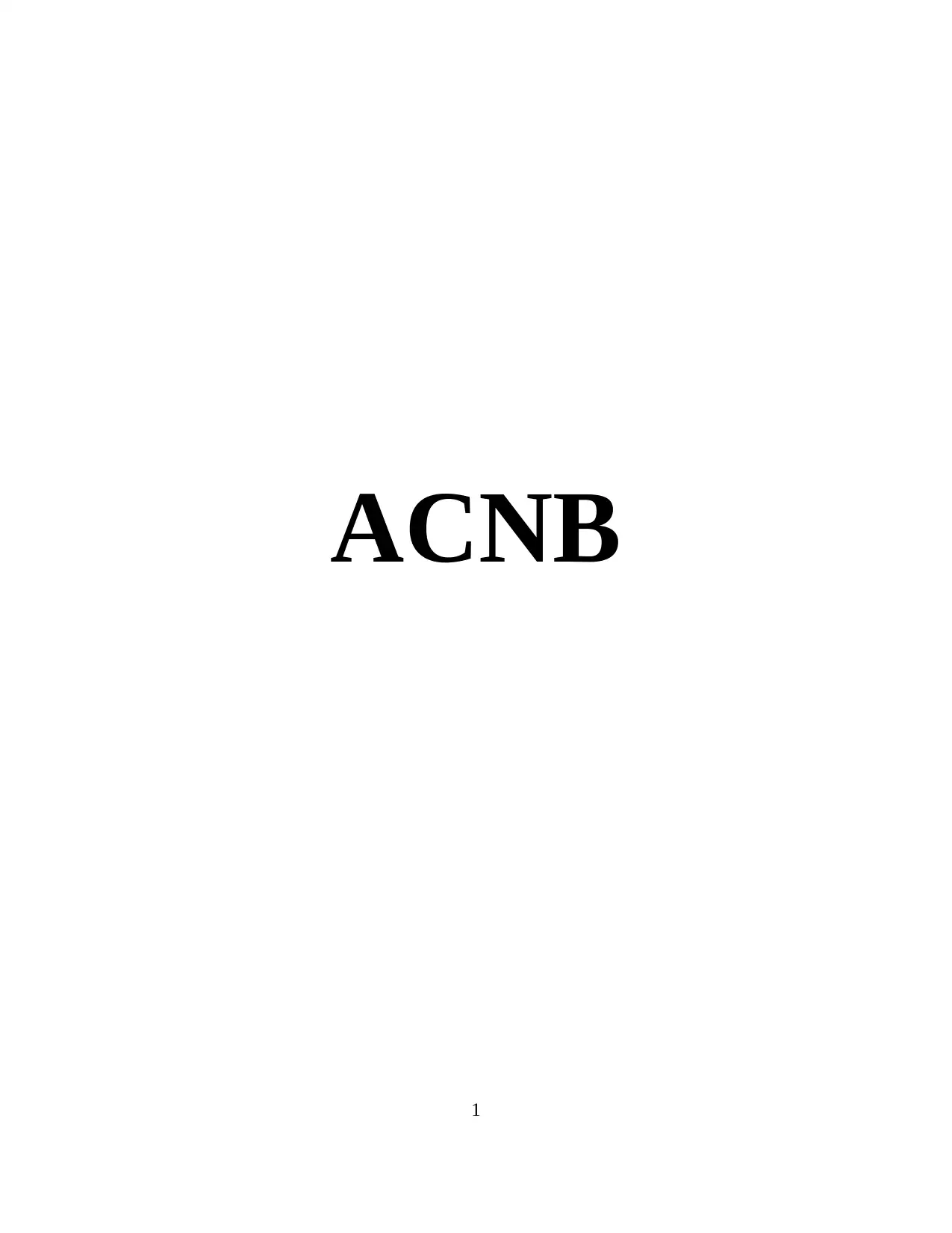
ACNB
1
1
Paraphrase This Document
Need a fresh take? Get an instant paraphrase of this document with our AI Paraphraser

Contract law is developed by English legislation to ensure standard performance by
parties. Further, this law describes obligation of damages in situation where parties fails to
provide satisfactory performance (Chadwick, 2011). Present study is based on description and
applicability of various provisions of the contract law. For better understanding of these
provisions previous case precedents will be considered.
LETTER 1
To,
Bob and Sam
Subject: Explanation of essential elements in a business context
Agreement formed by Bob and Sam will be considered legally enforceable only if
following elements of contract are present in it:
Offer and acceptance
There must be qualified offer and acceptance between parties to create valid agreement.
For this aspect, offer must be clear and specific (Taylor, 2011). It must not include ball park
estimates, invitation to treat or letter of intent. Further, acceptance must be on the terms that are
offered by offeror to offerree else it will be treated as the counter offer.
(Invitation to treat is distinct from the offer because it is mere declaration of willingness
for entering into negotiations. Thus, it cannot be accepted for forming contract.)
Intention to create legal relations
Contracting parties must have intention to enter into legal binding agreement to
accomplish their promises (Milner, 2011). This element is presumed to be part of the contract.
Consideration
Agreement of parties must be supported by valuable consideration (mutual exchange of
promises). It is not required to be fair but it must not be supported by duress, fraud or
unconscionable conduct.
Capacity:
Parties to the contract must be in the position to enter into legal enforceable agreement
(Nystén-Haarala, Lee and Lehto, 2010). For this aspect, they must not qualify quality of minor,
2
parties. Further, this law describes obligation of damages in situation where parties fails to
provide satisfactory performance (Chadwick, 2011). Present study is based on description and
applicability of various provisions of the contract law. For better understanding of these
provisions previous case precedents will be considered.
LETTER 1
To,
Bob and Sam
Subject: Explanation of essential elements in a business context
Agreement formed by Bob and Sam will be considered legally enforceable only if
following elements of contract are present in it:
Offer and acceptance
There must be qualified offer and acceptance between parties to create valid agreement.
For this aspect, offer must be clear and specific (Taylor, 2011). It must not include ball park
estimates, invitation to treat or letter of intent. Further, acceptance must be on the terms that are
offered by offeror to offerree else it will be treated as the counter offer.
(Invitation to treat is distinct from the offer because it is mere declaration of willingness
for entering into negotiations. Thus, it cannot be accepted for forming contract.)
Intention to create legal relations
Contracting parties must have intention to enter into legal binding agreement to
accomplish their promises (Milner, 2011). This element is presumed to be part of the contract.
Consideration
Agreement of parties must be supported by valuable consideration (mutual exchange of
promises). It is not required to be fair but it must not be supported by duress, fraud or
unconscionable conduct.
Capacity:
Parties to the contract must be in the position to enter into legal enforceable agreement
(Nystén-Haarala, Lee and Lehto, 2010). For this aspect, they must not qualify quality of minor,
2
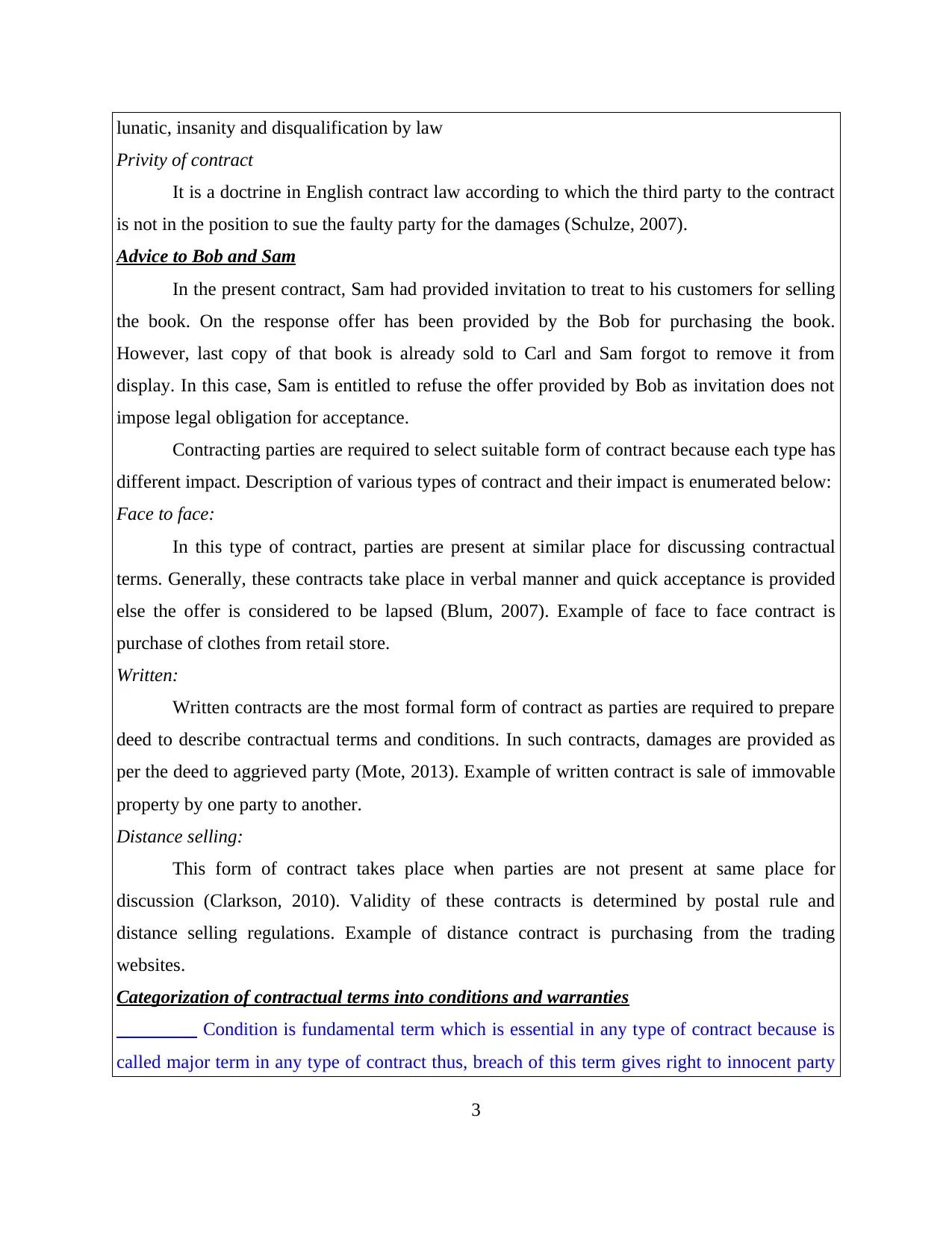
lunatic, insanity and disqualification by law
Privity of contract
It is a doctrine in English contract law according to which the third party to the contract
is not in the position to sue the faulty party for the damages (Schulze, 2007).
Advice to Bob and Sam
In the present contract, Sam had provided invitation to treat to his customers for selling
the book. On the response offer has been provided by the Bob for purchasing the book.
However, last copy of that book is already sold to Carl and Sam forgot to remove it from
display. In this case, Sam is entitled to refuse the offer provided by Bob as invitation does not
impose legal obligation for acceptance.
Contracting parties are required to select suitable form of contract because each type has
different impact. Description of various types of contract and their impact is enumerated below:
Face to face:
In this type of contract, parties are present at similar place for discussing contractual
terms. Generally, these contracts take place in verbal manner and quick acceptance is provided
else the offer is considered to be lapsed (Blum, 2007). Example of face to face contract is
purchase of clothes from retail store.
Written:
Written contracts are the most formal form of contract as parties are required to prepare
deed to describe contractual terms and conditions. In such contracts, damages are provided as
per the deed to aggrieved party (Mote, 2013). Example of written contract is sale of immovable
property by one party to another.
Distance selling:
This form of contract takes place when parties are not present at same place for
discussion (Clarkson, 2010). Validity of these contracts is determined by postal rule and
distance selling regulations. Example of distance contract is purchasing from the trading
websites.
Categorization of contractual terms into conditions and warranties
Condition is fundamental term which is essential in any type of contract because is
called major term in any type of contract thus, breach of this term gives right to innocent party
3
Privity of contract
It is a doctrine in English contract law according to which the third party to the contract
is not in the position to sue the faulty party for the damages (Schulze, 2007).
Advice to Bob and Sam
In the present contract, Sam had provided invitation to treat to his customers for selling
the book. On the response offer has been provided by the Bob for purchasing the book.
However, last copy of that book is already sold to Carl and Sam forgot to remove it from
display. In this case, Sam is entitled to refuse the offer provided by Bob as invitation does not
impose legal obligation for acceptance.
Contracting parties are required to select suitable form of contract because each type has
different impact. Description of various types of contract and their impact is enumerated below:
Face to face:
In this type of contract, parties are present at similar place for discussing contractual
terms. Generally, these contracts take place in verbal manner and quick acceptance is provided
else the offer is considered to be lapsed (Blum, 2007). Example of face to face contract is
purchase of clothes from retail store.
Written:
Written contracts are the most formal form of contract as parties are required to prepare
deed to describe contractual terms and conditions. In such contracts, damages are provided as
per the deed to aggrieved party (Mote, 2013). Example of written contract is sale of immovable
property by one party to another.
Distance selling:
This form of contract takes place when parties are not present at same place for
discussion (Clarkson, 2010). Validity of these contracts is determined by postal rule and
distance selling regulations. Example of distance contract is purchasing from the trading
websites.
Categorization of contractual terms into conditions and warranties
Condition is fundamental term which is essential in any type of contract because is
called major term in any type of contract thus, breach of this term gives right to innocent party
3
⊘ This is a preview!⊘
Do you want full access?
Subscribe today to unlock all pages.

Trusted by 1+ million students worldwide
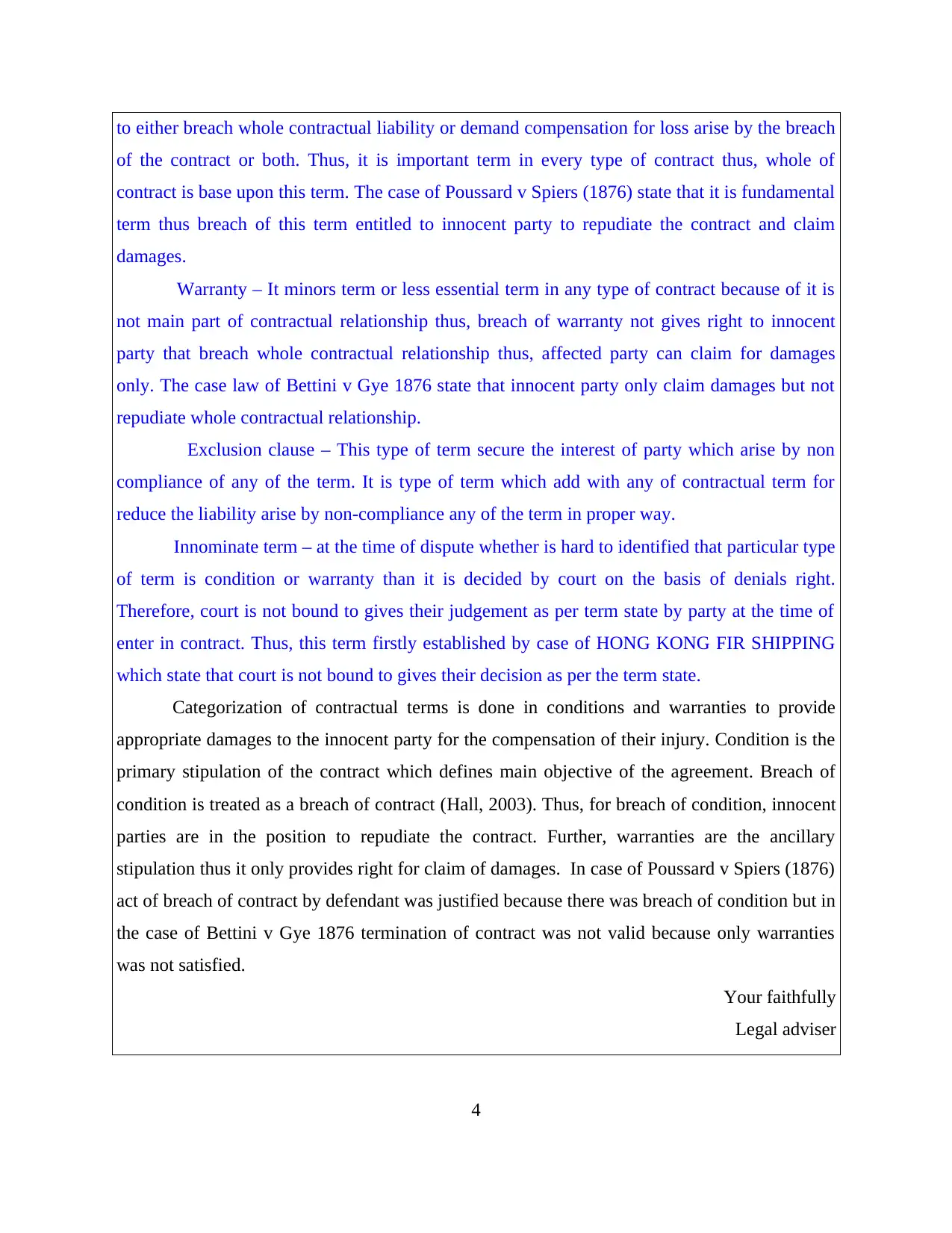
to either breach whole contractual liability or demand compensation for loss arise by the breach
of the contract or both. Thus, it is important term in every type of contract thus, whole of
contract is base upon this term. The case of Poussard v Spiers (1876) state that it is fundamental
term thus breach of this term entitled to innocent party to repudiate the contract and claim
damages.
Warranty – It minors term or less essential term in any type of contract because of it is
not main part of contractual relationship thus, breach of warranty not gives right to innocent
party that breach whole contractual relationship thus, affected party can claim for damages
only. The case law of Bettini v Gye 1876 state that innocent party only claim damages but not
repudiate whole contractual relationship.
Exclusion clause – This type of term secure the interest of party which arise by non
compliance of any of the term. It is type of term which add with any of contractual term for
reduce the liability arise by non-compliance any of the term in proper way.
Innominate term – at the time of dispute whether is hard to identified that particular type
of term is condition or warranty than it is decided by court on the basis of denials right.
Therefore, court is not bound to gives their judgement as per term state by party at the time of
enter in contract. Thus, this term firstly established by case of HONG KONG FIR SHIPPING
which state that court is not bound to gives their decision as per the term state.
Categorization of contractual terms is done in conditions and warranties to provide
appropriate damages to the innocent party for the compensation of their injury. Condition is the
primary stipulation of the contract which defines main objective of the agreement. Breach of
condition is treated as a breach of contract (Hall, 2003). Thus, for breach of condition, innocent
parties are in the position to repudiate the contract. Further, warranties are the ancillary
stipulation thus it only provides right for claim of damages. In case of Poussard v Spiers (1876)
act of breach of contract by defendant was justified because there was breach of condition but in
the case of Bettini v Gye 1876 termination of contract was not valid because only warranties
was not satisfied.
Your faithfully
Legal adviser
4
of the contract or both. Thus, it is important term in every type of contract thus, whole of
contract is base upon this term. The case of Poussard v Spiers (1876) state that it is fundamental
term thus breach of this term entitled to innocent party to repudiate the contract and claim
damages.
Warranty – It minors term or less essential term in any type of contract because of it is
not main part of contractual relationship thus, breach of warranty not gives right to innocent
party that breach whole contractual relationship thus, affected party can claim for damages
only. The case law of Bettini v Gye 1876 state that innocent party only claim damages but not
repudiate whole contractual relationship.
Exclusion clause – This type of term secure the interest of party which arise by non
compliance of any of the term. It is type of term which add with any of contractual term for
reduce the liability arise by non-compliance any of the term in proper way.
Innominate term – at the time of dispute whether is hard to identified that particular type
of term is condition or warranty than it is decided by court on the basis of denials right.
Therefore, court is not bound to gives their judgement as per term state by party at the time of
enter in contract. Thus, this term firstly established by case of HONG KONG FIR SHIPPING
which state that court is not bound to gives their decision as per the term state.
Categorization of contractual terms is done in conditions and warranties to provide
appropriate damages to the innocent party for the compensation of their injury. Condition is the
primary stipulation of the contract which defines main objective of the agreement. Breach of
condition is treated as a breach of contract (Hall, 2003). Thus, for breach of condition, innocent
parties are in the position to repudiate the contract. Further, warranties are the ancillary
stipulation thus it only provides right for claim of damages. In case of Poussard v Spiers (1876)
act of breach of contract by defendant was justified because there was breach of condition but in
the case of Bettini v Gye 1876 termination of contract was not valid because only warranties
was not satisfied.
Your faithfully
Legal adviser
4
Paraphrase This Document
Need a fresh take? Get an instant paraphrase of this document with our AI Paraphraser
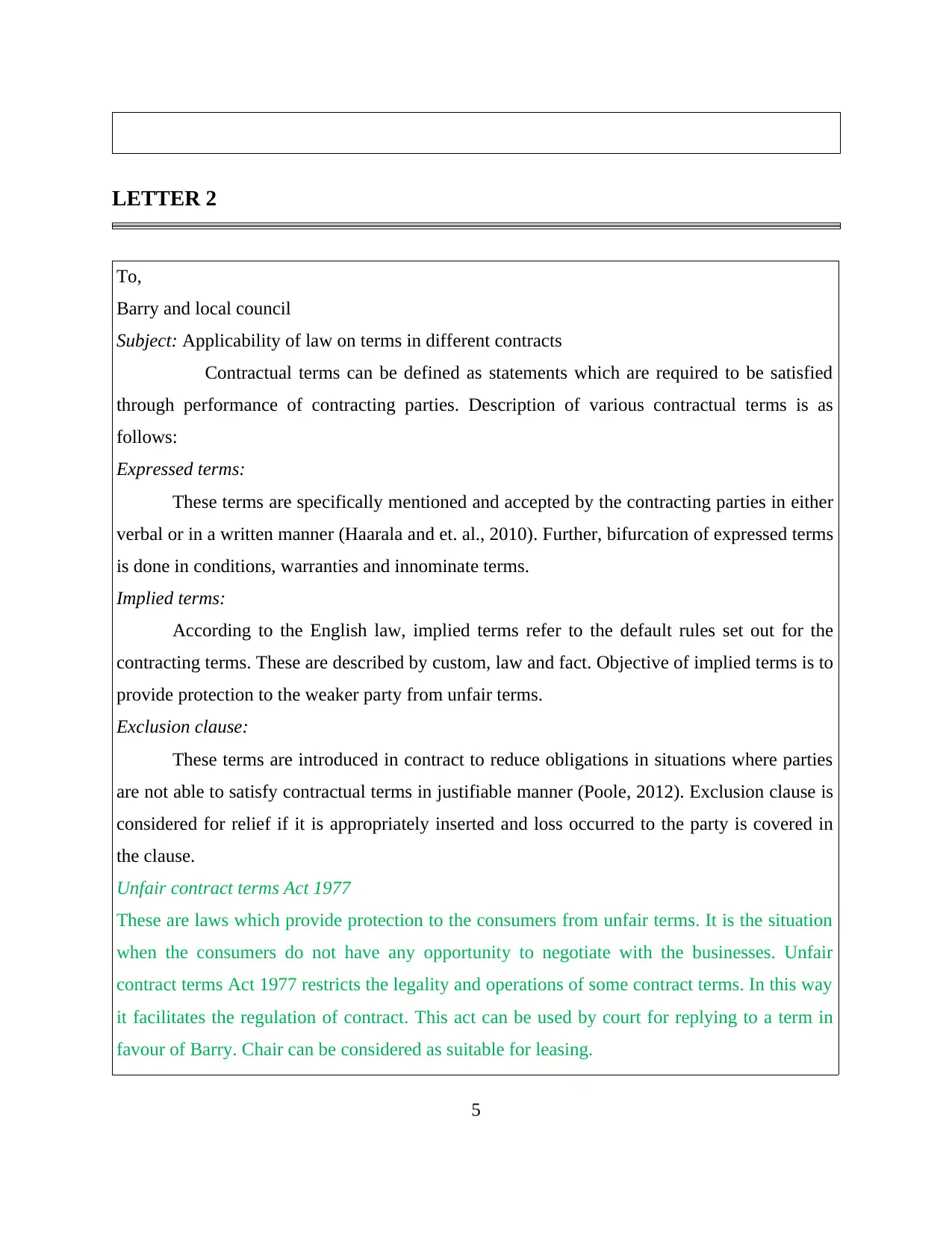
LETTER 2
To,
Barry and local council
Subject: Applicability of law on terms in different contracts
Contractual terms can be defined as statements which are required to be satisfied
through performance of contracting parties. Description of various contractual terms is as
follows:
Expressed terms:
These terms are specifically mentioned and accepted by the contracting parties in either
verbal or in a written manner (Haarala and et. al., 2010). Further, bifurcation of expressed terms
is done in conditions, warranties and innominate terms.
Implied terms:
According to the English law, implied terms refer to the default rules set out for the
contracting terms. These are described by custom, law and fact. Objective of implied terms is to
provide protection to the weaker party from unfair terms.
Exclusion clause:
These terms are introduced in contract to reduce obligations in situations where parties
are not able to satisfy contractual terms in justifiable manner (Poole, 2012). Exclusion clause is
considered for relief if it is appropriately inserted and loss occurred to the party is covered in
the clause.
Unfair contract terms Act 1977
These are laws which provide protection to the consumers from unfair terms. It is the situation
when the consumers do not have any opportunity to negotiate with the businesses. Unfair
contract terms Act 1977 restricts the legality and operations of some contract terms. In this way
it facilitates the regulation of contract. This act can be used by court for replying to a term in
favour of Barry. Chair can be considered as suitable for leasing.
5
To,
Barry and local council
Subject: Applicability of law on terms in different contracts
Contractual terms can be defined as statements which are required to be satisfied
through performance of contracting parties. Description of various contractual terms is as
follows:
Expressed terms:
These terms are specifically mentioned and accepted by the contracting parties in either
verbal or in a written manner (Haarala and et. al., 2010). Further, bifurcation of expressed terms
is done in conditions, warranties and innominate terms.
Implied terms:
According to the English law, implied terms refer to the default rules set out for the
contracting terms. These are described by custom, law and fact. Objective of implied terms is to
provide protection to the weaker party from unfair terms.
Exclusion clause:
These terms are introduced in contract to reduce obligations in situations where parties
are not able to satisfy contractual terms in justifiable manner (Poole, 2012). Exclusion clause is
considered for relief if it is appropriately inserted and loss occurred to the party is covered in
the clause.
Unfair contract terms Act 1977
These are laws which provide protection to the consumers from unfair terms. It is the situation
when the consumers do not have any opportunity to negotiate with the businesses. Unfair
contract terms Act 1977 restricts the legality and operations of some contract terms. In this way
it facilitates the regulation of contract. This act can be used by court for replying to a term in
favour of Barry. Chair can be considered as suitable for leasing.
5

Advice for contractual terms in present case
In the given case scenario, expressed terms is price stated by local council for hiring
chair. Further, implied term in the contract means both parties will perform in fair manner by
satisfying their contractual obligations. Statement stated on the backside of ticket that council
will not be liable for any kind of liability caused by failure of hired equipment will be
considered as an exclusion clause.
In accordance with the described case situation, chair provided by local council
collapsed due to which clothes of Barry got damaged. As a consequence, Barry complains to
the attendant but he pointed out at the exclusion clause and said that they will not be liable for
damages.
Legal provisions
Validity of exclusion clause is determined on the basis of following factors:
General rule of common law states that term must be incorporated in a contract prior to
the formation of contract. For this aspect, case of Thornton v Shoe Lane Parking [1971] 2 WLR
585 can be considered. In this case, clause was not considered as a part of contract because of
inappropriate incorporation.
Further, contra proferentem rule states that loss occurred to the party must be covered in
inserted exclusion clause (McKendrick, 2012). Case precedent of Andrews Bros ltd v Singer
Cars [1934] 1 KB 17 states that exclusion clause is not said to be effective if loss is not covered
in the clause.
In the described situation, case precedent of Chapleton V Barry can be considered. In
this case, defendant had inserted exclusion clause on the ticket on which court of law had
provided that decision ticket is merely a receipt in a contract. Thus, statements inserted on it
will not be considered as a part of the contract. On the basis of decision, court held claim of
claimant successful and he was entitled for the damage.
Dunlop v New Garage + Motor Co (1915)
This is an English contract law case. It is concerned to the extent to which one can seek
damages when there is a failure to perform a contract. In this case the court appeal held that the
clause was a penalty. Hence, only nominal damages were obtained by Dunlop and he appealed.
6
In the given case scenario, expressed terms is price stated by local council for hiring
chair. Further, implied term in the contract means both parties will perform in fair manner by
satisfying their contractual obligations. Statement stated on the backside of ticket that council
will not be liable for any kind of liability caused by failure of hired equipment will be
considered as an exclusion clause.
In accordance with the described case situation, chair provided by local council
collapsed due to which clothes of Barry got damaged. As a consequence, Barry complains to
the attendant but he pointed out at the exclusion clause and said that they will not be liable for
damages.
Legal provisions
Validity of exclusion clause is determined on the basis of following factors:
General rule of common law states that term must be incorporated in a contract prior to
the formation of contract. For this aspect, case of Thornton v Shoe Lane Parking [1971] 2 WLR
585 can be considered. In this case, clause was not considered as a part of contract because of
inappropriate incorporation.
Further, contra proferentem rule states that loss occurred to the party must be covered in
inserted exclusion clause (McKendrick, 2012). Case precedent of Andrews Bros ltd v Singer
Cars [1934] 1 KB 17 states that exclusion clause is not said to be effective if loss is not covered
in the clause.
In the described situation, case precedent of Chapleton V Barry can be considered. In
this case, defendant had inserted exclusion clause on the ticket on which court of law had
provided that decision ticket is merely a receipt in a contract. Thus, statements inserted on it
will not be considered as a part of the contract. On the basis of decision, court held claim of
claimant successful and he was entitled for the damage.
Dunlop v New Garage + Motor Co (1915)
This is an English contract law case. It is concerned to the extent to which one can seek
damages when there is a failure to perform a contract. In this case the court appeal held that the
clause was a penalty. Hence, only nominal damages were obtained by Dunlop and he appealed.
6
⊘ This is a preview!⊘
Do you want full access?
Subscribe today to unlock all pages.

Trusted by 1+ million students worldwide
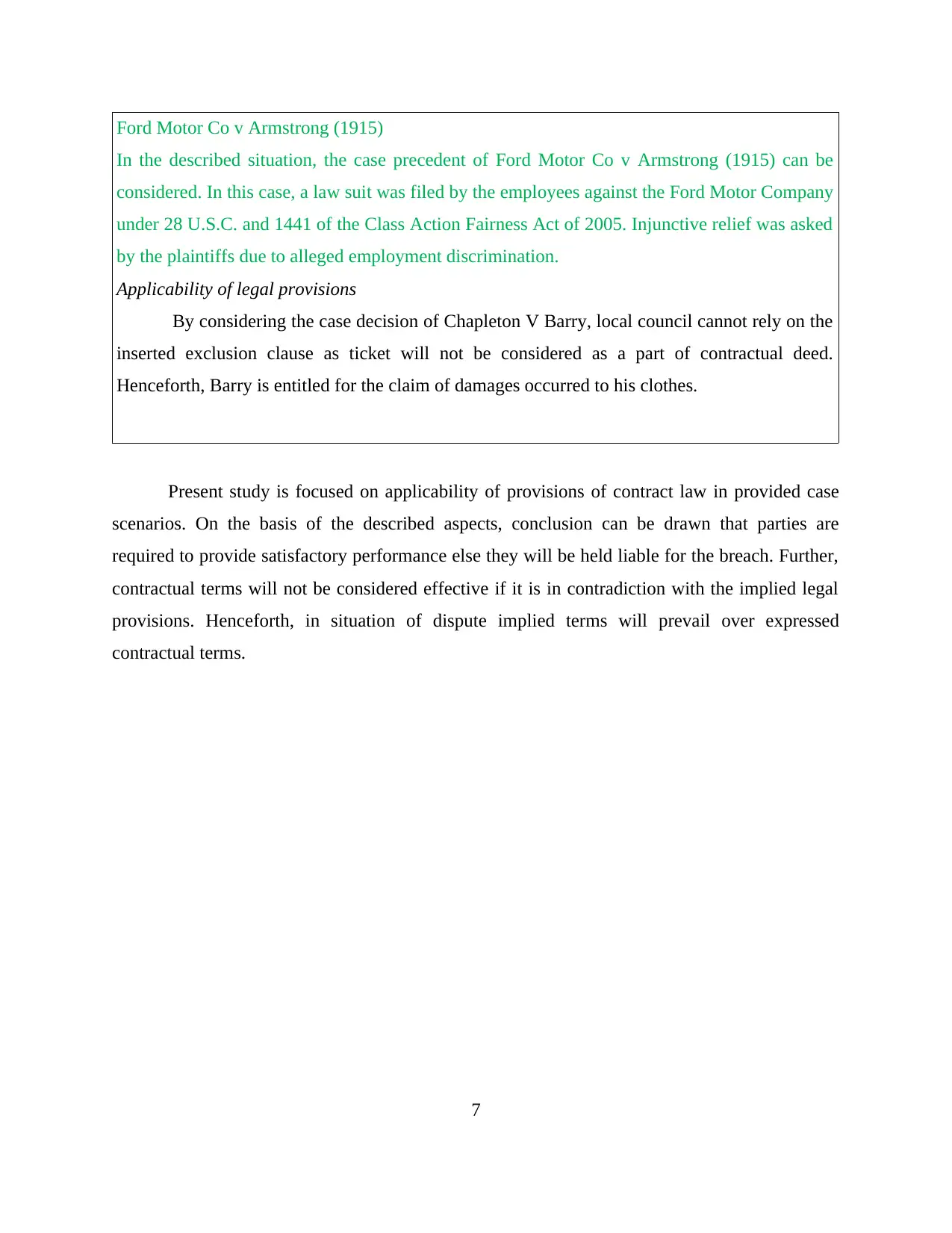
Ford Motor Co v Armstrong (1915)
In the described situation, the case precedent of Ford Motor Co v Armstrong (1915) can be
considered. In this case, a law suit was filed by the employees against the Ford Motor Company
under 28 U.S.C. and 1441 of the Class Action Fairness Act of 2005. Injunctive relief was asked
by the plaintiffs due to alleged employment discrimination.
Applicability of legal provisions
By considering the case decision of Chapleton V Barry, local council cannot rely on the
inserted exclusion clause as ticket will not be considered as a part of contractual deed.
Henceforth, Barry is entitled for the claim of damages occurred to his clothes.
Present study is focused on applicability of provisions of contract law in provided case
scenarios. On the basis of the described aspects, conclusion can be drawn that parties are
required to provide satisfactory performance else they will be held liable for the breach. Further,
contractual terms will not be considered effective if it is in contradiction with the implied legal
provisions. Henceforth, in situation of dispute implied terms will prevail over expressed
contractual terms.
7
In the described situation, the case precedent of Ford Motor Co v Armstrong (1915) can be
considered. In this case, a law suit was filed by the employees against the Ford Motor Company
under 28 U.S.C. and 1441 of the Class Action Fairness Act of 2005. Injunctive relief was asked
by the plaintiffs due to alleged employment discrimination.
Applicability of legal provisions
By considering the case decision of Chapleton V Barry, local council cannot rely on the
inserted exclusion clause as ticket will not be considered as a part of contractual deed.
Henceforth, Barry is entitled for the claim of damages occurred to his clothes.
Present study is focused on applicability of provisions of contract law in provided case
scenarios. On the basis of the described aspects, conclusion can be drawn that parties are
required to provide satisfactory performance else they will be held liable for the breach. Further,
contractual terms will not be considered effective if it is in contradiction with the implied legal
provisions. Henceforth, in situation of dispute implied terms will prevail over expressed
contractual terms.
7
Paraphrase This Document
Need a fresh take? Get an instant paraphrase of this document with our AI Paraphraser

REFERENCES
Books and Journals
Blum, A. B., 2007. Contracts: Examples & Explanation. Aspen Publishers Online.
Chadwick, A., 2011. The English Legal System. Straightforward co Ltd.
Clarkson, K.W., 2010. Business law. Text and Cases: Legal. Cengage learning.
Haarala, N. S. and et.al., 2010. Flexibility in contract terms and contracting processes.
International Journal of Managing Projects in Business. 3(3). pp. 462-478.
Hall, C. J., 2003. The contractual nature of social law. Managerial Law. 45(3/4). pp. 23-107.
McKendrick, E., 2012. Contract Law; Text, Cases, and Materials. Oxford University Press.
Milner, A., 2011. Contract interpretation: potential for relaxing the exclusionary rule.
International Journal of Law in the Built Environment. 3(3). pp.205 – 221.
Nystén-Haarala, S., Lee, N. and Lehto, J., 2010.Flexibility in contract terms and contracting
processes. International Journal of Managing Projects in Business. 3(3). pp.462 – 478.
Poole, J., 2012. Textbook on Contract Law. Oxford University Press, 2012.
Schulze, R., 2007. New feature in contract law. Sellier, European law publications.
Online
Mote, A., 2013. Types of Contracts. [Online]. Available through:
<http://www.buzzle.com/articles/types-of-contracts.html>. [Accessed on 29th February
2016].]
Taylor, A., 2011. Offer and acceptance online. [Online] Available through:
<http://www.seqlegal.com/blog/offer-and-acceptance-online>. [Accessed on 29th
February 2016].
8
Books and Journals
Blum, A. B., 2007. Contracts: Examples & Explanation. Aspen Publishers Online.
Chadwick, A., 2011. The English Legal System. Straightforward co Ltd.
Clarkson, K.W., 2010. Business law. Text and Cases: Legal. Cengage learning.
Haarala, N. S. and et.al., 2010. Flexibility in contract terms and contracting processes.
International Journal of Managing Projects in Business. 3(3). pp. 462-478.
Hall, C. J., 2003. The contractual nature of social law. Managerial Law. 45(3/4). pp. 23-107.
McKendrick, E., 2012. Contract Law; Text, Cases, and Materials. Oxford University Press.
Milner, A., 2011. Contract interpretation: potential for relaxing the exclusionary rule.
International Journal of Law in the Built Environment. 3(3). pp.205 – 221.
Nystén-Haarala, S., Lee, N. and Lehto, J., 2010.Flexibility in contract terms and contracting
processes. International Journal of Managing Projects in Business. 3(3). pp.462 – 478.
Poole, J., 2012. Textbook on Contract Law. Oxford University Press, 2012.
Schulze, R., 2007. New feature in contract law. Sellier, European law publications.
Online
Mote, A., 2013. Types of Contracts. [Online]. Available through:
<http://www.buzzle.com/articles/types-of-contracts.html>. [Accessed on 29th February
2016].]
Taylor, A., 2011. Offer and acceptance online. [Online] Available through:
<http://www.seqlegal.com/blog/offer-and-acceptance-online>. [Accessed on 29th
February 2016].
8
1 out of 8
Related Documents
Your All-in-One AI-Powered Toolkit for Academic Success.
+13062052269
info@desklib.com
Available 24*7 on WhatsApp / Email
![[object Object]](/_next/static/media/star-bottom.7253800d.svg)
Unlock your academic potential
Copyright © 2020–2025 A2Z Services. All Rights Reserved. Developed and managed by ZUCOL.





